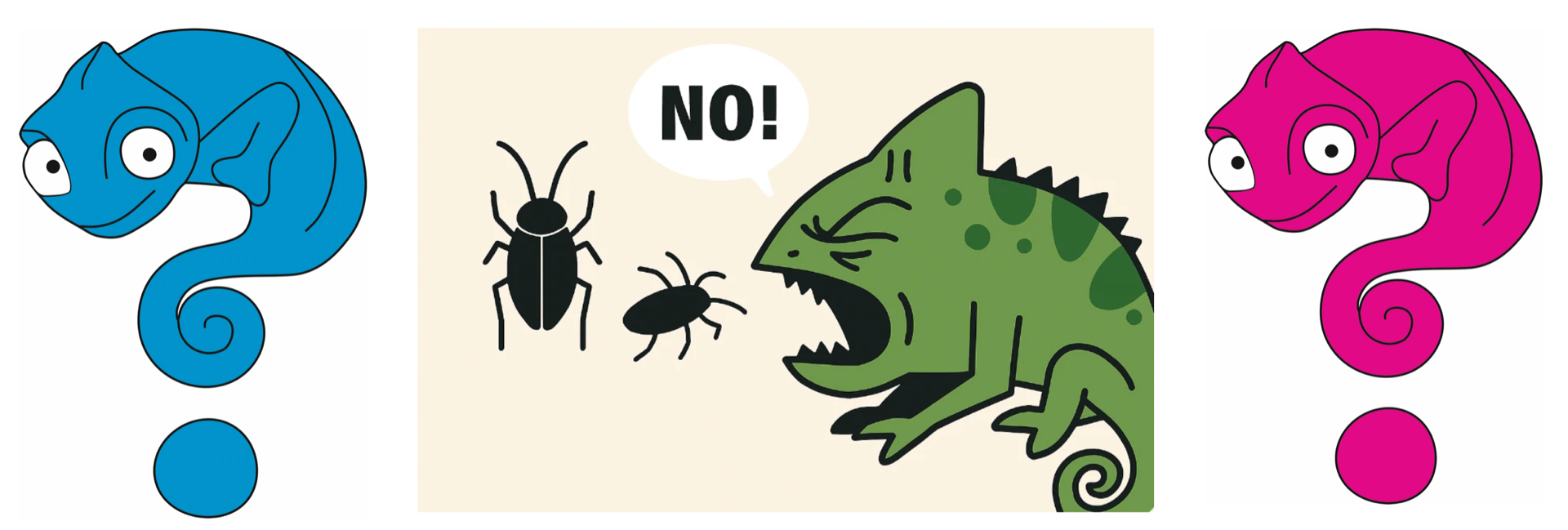Myth 3: "The Roach Loop: How Profit Logic Poisons Chameleons"

The chameleon diet in captivity is an enigma. We do not feed them what they eat in the wild — and instead feed them what they do not eat when free. This contradiction isn't just ironic. It's lethal.
Most keepers rely on food they can buy. That means commercial breeding of feeder insects — and here comes the trap. Commercial breeders do not operate for the beautiful eyes of chameleons. They operate for profit. Their logic is simple:
Breed what breeds easily,
Feed it cheaply,
Maximize profit.
Enter: roaches.
They're easy to breed, easy to feed, and easy to sell. The marketing machine spins them as "healthy," "nutritious," "ideal." The goal? Make them a staple. And once accepted — the circle is closed.
But here's where the disaster begins.
WHY ROACHES ARE A SILENT KILLER
1. Not Natural Prey
Roaches are not natural food for chameleons. In the wild, chameleons eat roaches extremely rarely. Why?
Roaches are nocturnal. Chameleons are diurnal.
Roaches live under bark and in leaf litter. Chameleons dwell on thin branches high in the trees.
They simply do not encounter each other. Feeding roaches is like feeding rats to hummingbirds.
2. Anatomical Mismatch
Roaches are often too big, too hard, and too spiky. Yes, chameleons are capable of feeding on remarkably large prey occasionally. Their jaws are powerful and can crush hard shells.
But their normal choice is to feed on rather small prey, very often. That's their natural rhythm.
The problem: the spikes on roach legs can easily puncture the gingiva. This tiny, seemingly harmless injury can develop — unnoticed — into an abscess or mouth rot.
Mouth rot is often deadly. It's silent. It's slow. And it's usually diagnosed too late.
3. Fat Overload
Roaches are fatty. Chameleons are adapted to a very low-energy diet.
Too high an energy influx is catastrophic. They get fat. Their organs collapse. They become immobile, infertile, lazy, tired, ill — and die.
4. Uric Acid Poisoning
Roaches have a unique metabolism. They store energy in the form of uric acid. Adults cannot reproduce without massive reserves of it.
When roaches become a staple diet, extreme doses of uric acid are absorbed into the bloodstream. Levels rise to 10× or more above what's acceptable.
And then the disaster unfolds:
Kidneys fail
They swell to 3–5× their normal size in a hopeless fight to purge the acid
The body collapses, poisoned
The growing kidney mass compresses lumbar nerves
Hind limbs and tail become paralyzed
The chameleon falls from a branch, terrified and stressed
In parallel, gout develops — joints swell, torn internally by sharp crystals of uric acid and its salts
This is not theoretical. It is observed. It is real.
5. Phosphorus Imbalance
Roaches are often raised on high-purine, high-protein diets — because it makes them grow and reproduce well.
This results in dangerously high phosphorus content.
If not compensated heavily with calcium, phosphorus blocks metabolism and damages kidneys.
We've already discussed the kidney apocalypse.
WHAT TO DO
Do not believe feeding roaches is a good idea. It is not. It is a terrible idea — one that leads to terrible pain, suffering, and guaranteed death.
If you must feed roaches:
Do it very rarely
Gut-load them for many weeks with a low-purine vegetarian diet
Feed only nymphs
Never feed adults
But better: abscond from feeding roaches entirely.
Otherwise, you will knowingly kill your chameleons. The damage to their organs is inevitable — and cannot be compensated by any means, long term.